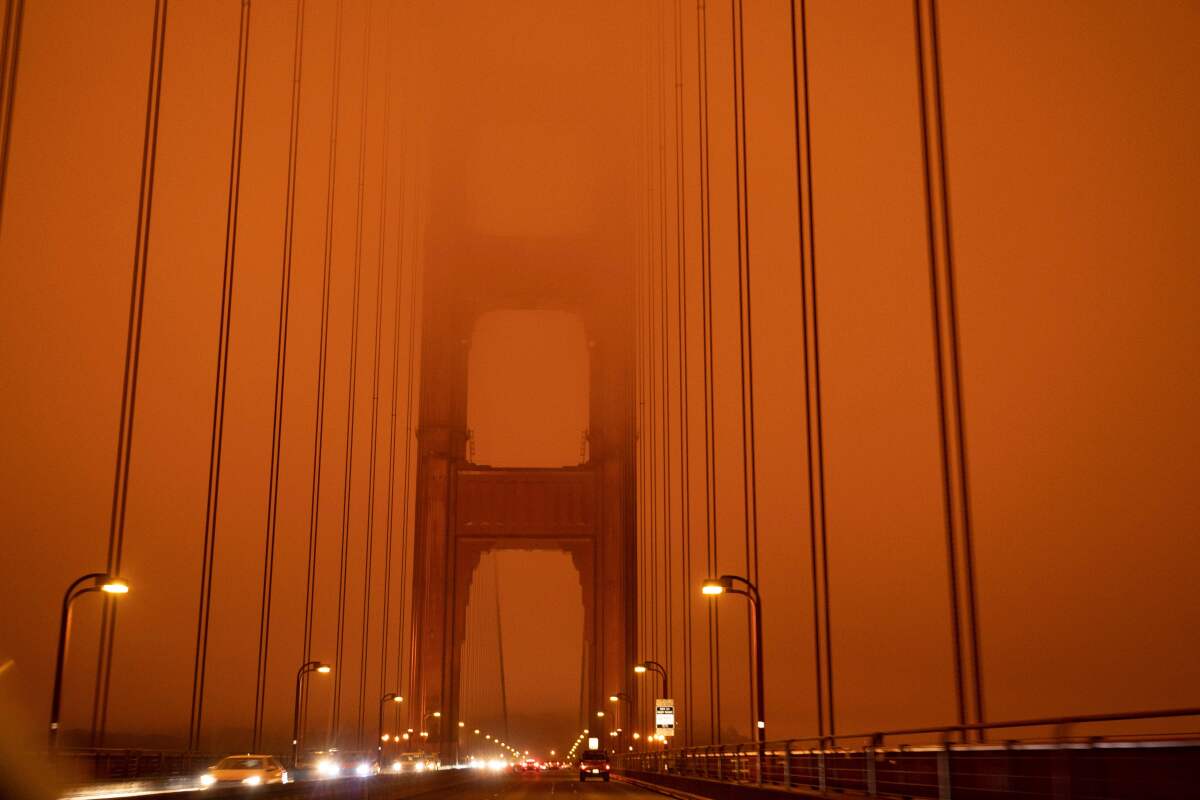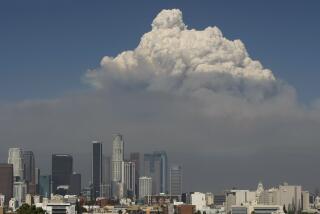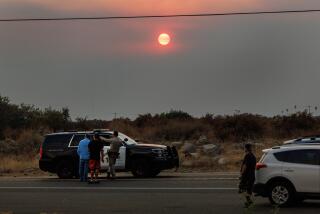Wildfire smoke may carry ‘mind-bending’ amounts of fungi and bacteria, scientists say

When wildfires roar through a forest and bulldozers dig into the earth to stop advancing flames, they may be churning more into the air than just clouds of dust and smoke, scientists say.
Those dark, billowing plumes of smoke that rise on waves of heat during the day and sink into valleys as the night air cools may be transporting countless living microbes that can seep into our lungs or cling to our skin and clothing, according to research published recently in Science. In some cases, researchers fear that airborne pathogens could sicken firefighters or downwind residents.
“We were inspired to write this because we recognize that there are many trillions of microbes in smoke that haven’t really been incorporated in an understanding ... of human health,” said Leda Kobziar, a University of Idaho associate professor in wildland fire science. “At this point, it’s really unknown. The diversity of microbes that we’ve found are really mind-bending.”
As this recent fire seasons suggests, the need to understand what’s in the wildfire smoke we can’t help but breathe and how it may affect us has never been more pronounced, but scientists say we are seriously behind the curve.
Wildfires burned across more than 10.2 million acres of the United States in 2020, federal statistics show, including some 4.2 million acres in California, where a greater number of residents were exposed to smoke for a longer period of time than ever before.
Wildfire smoke now accounts for up to half of all fine-particle pollution in the Western U.S., according to researchers. Although there are many studies on the long-term impacts to human health from urban air pollution and short-term impacts from wildfire smoke, there’s little known about the multitude of ways the latter can hurt us over a lifetime.
“Frankly, we don’t really know about the long-term effects of wildfire smoke because community exposures haven’t been long-term before,” said Dr. John Balmes, a professor of medicine at UC San Francisco and a member of the California Air Resources Board.
But humans — and Californians in particular — should expect to inhale more wildfire smoke in the future.
Scientists say the planet will continue warming for decades to come, even if humans suddenly collectively act to stop climate change. This warming, and other factors, are contributing to ever more destructive wildfires. The state’s forests, meanwhile, are struggling to adapt and native plants are being displaced by faster-burning invasive species.
Add to those trends a global pandemic that attacks the respiratory system, and microbe-filled fire smoke every year could be considered a growing health risk, researchers say. They wonder whether microbes in wildfire smoke could make cancer patients more vulnerable to infections or make children with asthma more prone to developing pneumonia.
Scientists believe some microbes survive and even proliferate in wildfire, where heat scorches the ground and leaves behind a layer of carbon that shields microbes within the earth from intense heat. Others survive in the air because wildfire particulates can absorb the sun’s otherwise lethal ultraviolet radiation, the scientists said. And still other spores are likely spread on wind currents caused by fire.
Kobziar and study co-author George Thompson III, an associate professor of medicine at UC Davis, said that up until now, the connection between microbes and wildfires has been anecdotal — such as the tendency for wildland firefighters to get sick with Valley fever after working on an incident. The illness is contracted by inhaling spores of the fungi genus Coccidioides.
“We have more questions than answers at this point,” Thompson said. “Our lungs are exposed to pathogens every day we don’t think much of. But [what] if we increase the number of microbes in there with fire?”
In 2018, for example, the Kern County Fire Department sought a $100,000 grant to get assistance in cutting fuel breaks — which disturb the soil — because their firefighters would get sick after doing the work. Data show that Valley fever cases spike on the county’s valley floor every fall, just as fire season is underway in the surrounding hills.
“Aerosolized, microbes, spores, or fungal conidia … have the potential to travel hundreds of miles, depending on fire behavior and atmospheric conditions, and are eventually deposited or inhaled downwind of a fire,” Kobziar and Thompson wrote in their paper.
Yet, determining what pathogens exist in wildfire smoke has been difficult.
The National Oceanic and Atmospheric Administration, NASA and team of chemists, physicists, biologists and forest and fire ecologists from a number of universities have been collaborating for years to study wildfire smoke around the country, under the assumption that nobody will be immune to its effects in the future.
“As the climate changes, as the temperature warms up, as we build houses in places that are surrounded by human populations and housing development expand into regions susceptible to fires, it’s a matter of time,” said Berry Lefero, manager of NASA’s Tropospheric Composition Program, which includes a DC-8 jetliner that circles the globe studying wildfire smoke, ozone and aerosols in the atmosphere’s lower layer.
Through the combined work of these researchers, scientists hope, the public and healthcare workers will one day be able to receive timely, accurate forecasts on where wildfire smoke will go, what specific health hazards it poses, and what people in its path should do to prepare beyond the boilerplate advice to stay indoors.
To solve the riddle of what microbes are in the smoke and why, Kobziar and Thompson need to understand what type of fuel is burning, like a grass, shrub, or tree; how much of it there was initially; how severely it was burned (was it just scorched black or completely reduced to ash or something in between?); and where the smoke originated.
Once those variables are determined, there’s the complicated task of actually capturing the smoke, which is by no means uniform, Kobziar said.
In September, Kobziar used a drone to capture samples of the air over Idaho when it was inundated with smoke from fires in Eastern Washington and Oregon. She then placed the samples in a petri dish, added some food that microbes like to eat and waited to see what would happen.
“Even a couple hundred miles away from the source of the smoke, it was still significant,” Kobziar said. “We’re still trying to isolate all the things we found.”
Tim Edwards, president of the firefighters union Local 2881, which represents thousands in the California Department of Forestry and Fire Protection, hopes the scientists’ work can boost his own efforts to get wildland firefighters respirators, since they typically just rely on face masks or bandanas — unlike their urban firefighting counterparts.
It’s not only the dust kicked up in a fire that gets crews sick, Edwards said.
“Now, in a wildland conflagration, you have 1,000 homes burning,” he said. “You burn the house, you don’t know what chemicals they have in that house, all that is on fire and that’s going in your lungs.”
More to Read
Sign up for Essential California
The most important California stories and recommendations in your inbox every morning.
You may occasionally receive promotional content from the Los Angeles Times.











